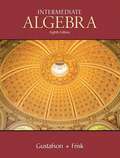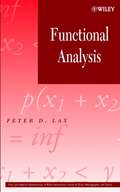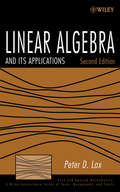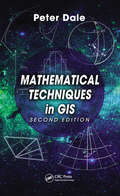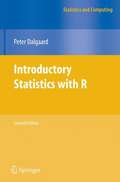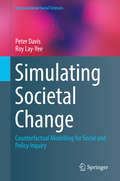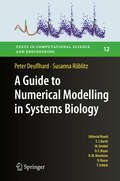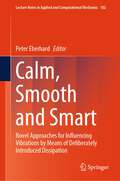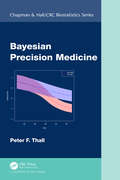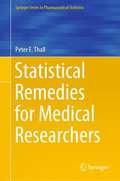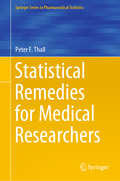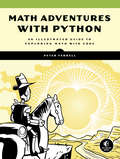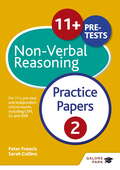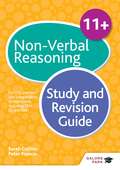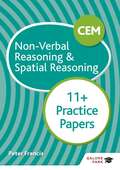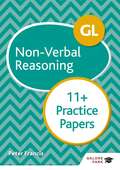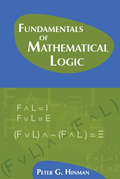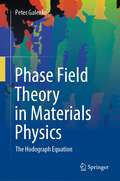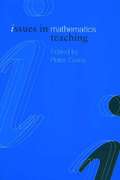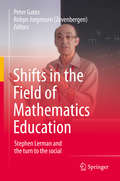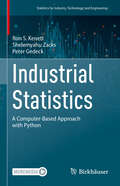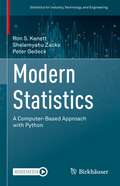- Table View
- List View
Intermediate Algebra (8th Edition)
by R. David Gustafson Peter D. FriskGet the grade you want in algebra with Gustafson and Frisk's INTERMEDIATE ALGEBRA! Written with you in mind, the authors provide clear, no-nonsense explanations that will help you learn difficult concepts with ease. Prepare for exams with numerous resources located online and throughout the text such as online tutoring, Chapter Summaries, Self-Checks, Getting Ready exercises, and Vocabulary and Concept problems. Use this text, and you'll learn solid mathematical skills that will help you both in future mathematical courses and in real life!
Functional Analysis
by Peter D. LaxIncludes sections on the spectral resolution and spectral representation of self adjoint operators, invariant subspaces, strongly continuous one-parameter semigroups, the index of operators, the trace formula of Lidskii, the Fredholm determinant, and more.* Assumes prior knowledge of Naive set theory, linear algebra, point set topology, basic complex variable, and real variables.* Includes an appendix on the Riesz representation theorem.
Linear Algebra and Its Applications
by Peter D. LaxLinear Algebra and Its Applications, Second Edition presents linear algebra as the theory and practice of linear spaces and linear maps with a unique focus on the analytical aspects as well as the numerous applications of the subject. In addition to thorough coverage of linear equations, matrices, vector spaces, game theory, and numerical analysis, the Second Edition features student-friendly additions that enhance the book's accessibility, including expanded topical coverage in the early chapters, additional exercises, and solutions to selected problems.Beginning chapters are devoted to the abstract structure of finite dimensional vector spaces, and subsequent chapters address convexity and the duality theorem as well as describe the basics of normed linear spaces and linear maps between normed spaces.Further updates and revisions have been included to reflect the most up-to-date coverage of the topic, including:The QR algorithm for finding the eigenvalues of a self-adjoint matrix. The Householder algorithm for turning self-adjoint matrices into tridiagonal form. The compactness of the unit ball as a criterion of finite dimensionality of a normed linear space. Additionally, eight new appendices have been added and cover topics such as: the Fast Fourier Transform; the spectral radius theorem; the Lorentz group; the compactness criterion for finite dimensionality; the characterization of commentators; proof of Liapunov's stability criterion; the construction of the Jordan Canonical form of matrices; and Carl Pearcy's elegant proof of Halmos' conjecture about the numerical range of matrices.Clear, concise, and superbly organized, Linear Algebra and Its Applications, Second Edition serves as an excellent text for advanced undergraduate- and graduate-level courses in linear algebra. Its comprehensive treatment of the subject also makes it an ideal reference or self-study for industry professionals.
Mathematical Techniques in GIS
by Peter DaleThe second edition of a bestseller, Mathematical Techniques in GIS demystifies the mathematics used in the manipulation of spatially related data. The author takes a step-by-step approach through the basics of arithmetic, algebra, geometry, trigonometry and calculus that underpin the management of such data. He then explores the use of matrices, de
Introductory Statistics with R, (Statistics and Computing Series)
by Peter DalgaardThe statistical methodology covered includes statistical standard distributions, one- and two-sample tests with continuous data, regression analysis, one-and two-way analysis of variance, regression analysis, analysis of tabular data, and sample size calculations. In addition, the last four chapters contain introductions to multiple linear regression analysis, linear models in general, logistic regression, and survival analysis.
Simulating Societal Change: Counterfactual Modelling for Social and Policy Inquiry (Computational Social Sciences)
by Peter Davis Roy Lay-YeeThis book presents a method for creating a working model of society, using data systems and simulation techniques, that can be used for testing propositions of scientific and policy nature. The model is based on the example of New Zealand, but will be applicable to other countries. It is expected that collaborators in other countries can emulate this example with their data systems for teaching and policy purposes, producing a cross-national "collaboratory". This enterprise will evolve with, and to a degree independently of, the book itself, with a supporting website as well as teaching and scientific initiatives. Readers of this text will, for the first time, have a simulation-based working model of society that can be interrogated for policy and substantive purposes. This book will appeal to researchers and professionals from various disciplines working within the social sciences, particularly on matters of demography and public policy.
A Guide to Numerical Modelling in Systems Biology (Texts in Computational Science and Engineering #12)
by Peter Deuflhard Susanna RöblitzThis book is intended for students of computational systems biology with only a limited background in mathematics. Typical books on systems biology merely mention algorithmic approaches, but without offering a deeper understanding. On the other hand, mathematical books are typically unreadable for computational biologists. The authors of the present book have worked hard to fill this gap. The result is not a book on systems biology, but on computational methods in systems biology. This book originated from courses taught by the authors at Freie Universität Berlin. The guiding idea of the courses was to convey those mathematical insights that are indispensable for systems biology, teaching the necessary mathematical prerequisites by means of many illustrative examples and without any theorems. The three chapters cover the mathematical modelling of biochemical and physiological processes, numerical simulation of the dynamics of biological networks and identification of model parameters by means of comparisons with real data. Throughout the text, the strengths and weaknesses of numerical algorithms with respect to various systems biological issues are discussed. Web addresses for downloading the corresponding software are also included.
Difference Equations by Differential Equation Methods
by Peter E. HydonMost well-known solution techniques for differential equations exploit symmetry in some form. Systematic methods have been developed for finding and using symmetries, first integrals and conservation laws of a given differential equation. Here the author explains how to extend these powerful methods to difference equations, greatly increasing the range of solvable problems. Beginning with an introduction to elementary solution methods, the book gives readers a clear explanation of exact techniques for ordinary and partial difference equations. The informal presentation is suitable for anyone who is familiar with standard differential equation methods. No prior knowledge of difference equations or symmetry is assumed. The author uses worked examples to help readers grasp new concepts easily. There are 120 exercises of varying difficulty and suggestions for further reading. The book goes to the cutting edge of research; its many new ideas and methods make it a valuable reference for researchers in the field.
Calm, Smooth and Smart: Novel Approaches for Influencing Vibrations by Means of Deliberately Introduced Dissipation (Lecture Notes in Applied and Computational Mechanics #102)
by Peter EberhardThis book contains and summarizes research carried out within the DFG Priority Programme 1897: "Calm, Smooth and Smart - Novel Approaches for Influencing Vibrations by Means of Deliberately Introduced Dissipation". The contributions help reduce unwanted vibrations by developing novel approaches for influencing them and lead to a “calm, smooth and smart” behaviour of technical units. “Calm” represents the demand to avoid or at least to severely reduce unwanted noise generated by technical installations. “Smooth” ensures a still comfortable and jerk-free operation of them. Finally, “smart” means that the introduced damping devices not only help to achieve the desired vibrational behaviour of the overall technical systems, but also that they take over additional functional tasks. The results presented in this volume summarize the state-of-the-art and provide motivation for future research. The book is intended for experienced researchers as well as for doctoral and post-doctoral students in engineering, mathematics and physics, as well as industrial researchers interested in the field.
Bayesian Precision Medicine (Chapman & Hall/CRC Biostatistics Series)
by Peter F. ThallBayesian Precision Medicine presents modern Bayesian statistical models and methods for identifying treatments tailored to individual patients using their prognostic variables and predictive biomarkers. The process of evaluating and comparing treatments is explained and illustrated by practical examples, followed by a discussion of causal analysis and its relationship to statistical inference. A wide array of modern Bayesian clinical trial designs are presented, including applications to many oncology trials. The later chapters describe Bayesian nonparametric regression analyses of datasets arising from multistage chemotherapy for acute leukemia, allogeneic stem cell transplantation, and targeted agents for treating advanced breast cancer.Features: Describes the connection between causal analysis and statistical inference Reviews modern personalized Bayesian clinical trial designs for dose-finding, treatment screening, basket trials, enrichment, incorporating historical data, and confirmatory treatment comparison, illustrated by real-world applications Presents adaptive methods for clustering similar patient subgroups to improve efficiency Describes Bayesian nonparametric regression analyses of real-world datasets from oncology Provides pointers to software for implementation Bayesian Precision Medicine is primarily aimed at biostatisticians and medical researchers who desire to apply modern Bayesian methods to their own clinical trials and data analyses. It also might be used to teach a special topics course on precision medicine using a Bayesian approach to postgraduate biostatistics students. The main goal of the book is to show how Bayesian thinking can provide a practical scientific basis for tailoring treatments to individual patients.
Statistical Remedies for Medical Researchers (Springer Series in Pharmaceutical Statistics)
by Peter F. ThallThis book illustrates numerous statistical practices that are commonly used by medical researchers, but which have severe flaws that may not be obvious. For each example, it provides one or more alternative statistical methods that avoid misleading or incorrect inferences being made. The technical level is kept to a minimum to make the book accessible to non-statisticians. At the same time, since many of the examples describe methods used routinely by medical statisticians with formal statistical training, the book appeals to a broad readership in the medical research community.
Statistical Remedies for Medical Researchers (Springer Series in Pharmaceutical Statistics)
by Peter F. ThallThis book illustrates numerous statistical practices that are commonly used by medical researchers, but which have severe flaws that may not be obvious. For each example, it provides one or more alternative statistical methods that avoid misleading or incorrect inferences being made. The technical level is kept to a minimum to make the book accessible to non-statisticians. At the same time, since many of the examples describe methods used routinely by medical statisticians with formal statistical training, the book appeals to a broad readership in the medical research community.
Math Adventures with Python: An Illustrated Guide to Exploring Math with Code
by Peter FarrellLearn math by getting creative with code! Use the Python programming language to transform learning high school-level math topics like algebra, geometry, trigonometry, and calculus!Math Adventures with Python will show you how to harness the power of programming to keep math relevant and fun. With the aid of the Python programming language, you'll learn how to visualize solutions to a range of math problems as you use code to explore key mathematical concepts like algebra, trigonometry, matrices, and cellular automata.Once you've learned the programming basics like loops and variables, you'll write your own programs to solve equations quickly, make cool things like an interactive rainbow grid, and automate tedious tasks like factoring numbers and finding square roots. You'll learn how to write functions to draw and manipulate shapes, create oscillating sine waves, and solve equations graphically. You'll also learn how to: - Draw and transform 2D and 3D graphics with matrices- Make colorful designs like the Mandelbrot and Julia sets with complex numbers- Use recursion to create fractals like the Koch snowflake and the Sierpinski triangle- Generate virtual sheep that graze on grass and multiply autonomously - Crack secret codes using genetic algorithms As you work through the book's numerous examples and increasingly challenging exercises, you'll code your own solutions, create beautiful visualizations, and see just how much more fun math can be!
11+ Non-Verbal Reasoning Practice Papers 2: For 11+, pre-test and independent school exams including CEM, GL and ISEB
by Peter Francis Sarah CollinsPrepare for the most challenging of pre-tests and 11+ independent school entrance exams with six levelled exam papers designed to test pupils' skills in Non-Verbal Reasoning exams for a better chance at getting into their school of choice. - Develops and perfects exam technique for all major pre-test and 11+ independent school exams including CEM, GL and ISEB- Features levelled papers to help build skills for the top marks - Teaches pupils to improve their response rates with timed papers- Builds exam-room confidence by practising with a variety of exam paper styles- Identifies weaker areas and improves results with detailed answers and commentaryAlso available for 11+ Non-Verbal Reasoning preparation: · 11+ Non-Verbal Reasoning Revision Guide ISBN xxx· Non-Verbal Reasoning Workbook Age 8-10 ISBN xxx· Non-Verbal Reasoning Workbook Age 9-11 ISBN xxx· Non-Verbal Reasoning Workbook Age 10-12 ISBN xx Revision Guides, Workbooks and Practice Papers are also available for Maths, English, Science and Verbal Reasoning on www.galorepark.co.uk.
11+ Non-Verbal Reasoning Study and Revision Guide: For 11+, pre-test and independent school exams including CEM, GL and ISEB
by Peter Francis Sarah CollinsExam Board: ISEBLevel: 11 PlusSubject: Non-Verbal ReasoningFirst Teaching: September 2016First Exam: Spring 2017Secure the top marks in 11 plus independent school entrance exams and pre-tests and a better chance at getting into their school of choice with this essential study and revision guide. Stretching content ensures that all the Non-Verbal Reasoning skills are thoroughly revised ahead of the exams.- Explains and tests the full range of question types and skills met in Non-Verbal Reasoning in exams- Prepares pupils for a wide range of independent school exams and pre-tests with challenging extension material- Builds on existing knowledge with clear cross-curricular links to English- Features helpful insight in to the exams, with examples, practical tips and advice- Prepares pupils for exam conditions with timed and levelled exam-style questions- Identifies strengths and weaknesses using 11 plus sample tests with detailed answer guidanceAlso available for 11 Plus Verbal Reasoning preparation: - Non-Verbal Reasoning Workbook Age 8-10 - Non-Verbal Reasoning Workbook Age 9-11 - Non Verbal Reasoning Workbook Age 10-12 - 11+ Non- Verbal Reasoning Practice Papers 1&2Revision Guides, Workbooks and Practice Papers are also available for Maths, English, Science and Verbal Reasoning on www.galorepark.co.uk
CEM 11+ Non-Verbal Reasoning & Spatial Reasoning Practice Papers: For 11+, Pre-test And Independent School Exams Including Cem, Gl And Iseb
by Peter FrancisThese three practice exam papers test pupils ahead of the CEM 11+ Non-Verbal Reasoning test, including those taking bespoke tests created by CEM for individual schools. Three levelled papers test pupils' skills in non-verbal and spatial reasoning.The papers are designed to:- Develop and perfect exam technique for all CEM 11+ Non-Verbal Reasoning tests- Teach pupils to improve their response rates with timed papers- Identify weaker areas and improve results by studying the answers, which contain references to Galore Park's revision materials for guidance and useful tips- The resource also contains links to downloadable answer sheets so that the tests can be re-sat.These practice papers are part of Galore Park's 11+ revision series, which provides a three-step learning journey that teaches children the skills needed to pass rigorous school entrance exams.
GL 11+ Non-Verbal Reasoning Practice Papers: For 11+, Pre-test And Independent School Exams Including Cem, Gl And Iseb
by Peter FrancisThree practice exam papers to test pupils ahead of the GL 11+ Non-Verbal Reasoning test,including those taking bespoke tests created by GL for individual schools. The papers are designed to:- Develop and perfect exam technique for GL 11+ Non-Verbal Reasoning tests- Teach pupils to improve their response rates with timed papers- Identify weaker areas and improve results by studying the answers, which contain references to Galore Park's revision materials for guidance and useful tips- The resource also contains links to downloadable answer sheets so that the tests can be re-sat.These practice papers are part of Galore Park's 11+ revision series, which provides a three-step learning journey that teaches children the skills needed to pass rigorous school entrance exams.
Macroeconomic Forecasting in the Era of Big Data: Theory and Practice (Advanced Studies in Theoretical and Applied Econometrics #52)
by Peter FulekyThis book surveys big data tools used in macroeconomic forecasting and addresses related econometric issues, including how to capture dynamic relationships among variables; how to select parsimonious models; how to deal with model uncertainty, instability, non-stationarity, and mixed frequency data; and how to evaluate forecasts, among others. Each chapter is self-contained with references, and provides solid background information, while also reviewing the latest advances in the field. Accordingly, the book offers a valuable resource for researchers, professional forecasters, and students of quantitative economics.
Fundamentals of Mathematical Logic
by Peter G. HinmanThis introductory graduate text covers modern mathematical logic from propositional, first-order and infinitary logic and Gödel's Incompleteness Theorems to extensive introductions to set theory, model theory and recursion (computability) theory. Based on the author's more than 35 years of teaching experience, the book develops students' intuition by presenting complex ideas in the simplest context for which they make sense. The book is appropriate for use as a classroom text, for self-study, and as a reference on the state of modern logic.
Gray Dawn: How the Coming Age Will Transform America and the World
by Peter G. PetersonHow Aging is changing our world.
Phase Field Theory in Materials Physics: The Hodograph Equation
by Peter GalenkoThis book deals with the use of the hodograph equation in phase transformations in condensed matter, especially, for crystallization and solidification processes. The main focus of the book is the interpretation of the phase-field equations for isotropic and anisotropic interfaces based on the advanced Gibbs–Thomson and Herring conditions, respectively. Beginning with the basic ideas behind the extended irreversible thermodynamics, the kinetic phase-field model for slow and arbitrarily fast phase transformations is derived where the unified hodograph equation follows from:• the sharp interface limit of the diffuse interface or• the traveling wave solution of the propagating phase field.Under the example of solute trapping and disorder trapping effects, comparing theoretical results with molecular dynamics simulations, and with the analysis of experimental data, the concrete workability of the developed hodograph equation is demonstrated for widest range of driving force in phase transformations.
Issues in Mathematics Teaching (Issues in Teaching Series)
by Peter GatesThis book presents the key debates that the mathematics teacher will need to understand, reflect on and engage in as part of their professional development. Issues in Mathematics Teaching is suitable for those at initial training level right through to practising mathematics teachers. Its accessible structure enables the reader to pursue the issues raised as each chapter includes suggestions for further reading and questions for reflection or debate.
Shifts in the Field of Mathematics Education
by Peter Gates Robyn JorgensenProfessor Stephen Lerman has been a leader in the field of mathematics education for thirty years. His work is extensive, making many significant contributions to a number of key areas of research. Stephen retired from South Bank University in 2012, where he had worked for over 20 years, though he continues to work at Loughborough University. In this book several of his long standing colleagues and collaborators reflect on his contribution to mathematics education, and in so doing illustrate how some of Steve's ideas and interventions have resulted in significant shifts in the domain.
Industrial Statistics: A Computer-Based Approach with Python (Statistics for Industry, Technology, and Engineering)
by Shelemyahu Zacks Ron S. Kenett Peter GedeckThis innovative textbook presents material for a course on industrial statistics that incorporates Python as a pedagogical and practical resource. Drawing on many years of teaching and conducting research in various applied and industrial settings, the authors have carefully tailored the text to provide an ideal balance of theory and practical applications. Numerous examples and case studies are incorporated throughout, and comprehensive Python applications are illustrated in detail. A custom Python package is available for download, allowing students to reproduce these examples and explore others.The first chapters of the text focus on the basic tools and principles of process control, methods of statistical process control (SPC), and multivariate SPC. Next, the authors explore the design and analysis of experiments, quality control and the Quality by Design approach, computer experiments, and cybermanufacturing and digital twins. The text then goes on to cover reliability analysis, accelerated life testing, and Bayesian reliability estimation and prediction. A final chapter considers sampling techniques and measures of inspection effectiveness. Each chapter includes exercises, data sets, and applications to supplement learning.Industrial Statistics: A Computer-Based Approach with Python is intended for a one- or two-semester advanced undergraduate or graduate course. In addition, it can be used in focused workshops combining theory, applications, and Python implementations. Researchers, practitioners, and data scientists will also find it to be a useful resource with the numerous applications and case studies that are included. A second, closely related textbook is titled Modern Statistics: A Computer-Based Approach with Python. It covers topics such as probability models and distribution functions, statistical inference and bootstrapping, time series analysis and predictions, and supervised and unsupervised learning. These texts can be used independently or for consecutive courses.This book is part of an impressive and extensive write up enterprise (roughly 1,000 pages!) which led to two books published by Birkhäuser. This book is on Industrial Statistics, an area in which the authors are recognized as major experts. The book combines classical methods (never to be forgotten!) and “hot topics” like cyber manufacturing, digital twins, A/B testing and Bayesian reliability. It is written in a very accessible style, focusing not only on HOW the methods are used, but also on WHY. In particular, the use of Python, throughout the book is highly appreciated. Python is probably the most important programming language used in modern analytics. The authors are warmly thanked for providing such a state-of-the-art book. It provides a comprehensive illustration of methods and examples based on the authors longstanding experience, and accessible code for learning and reusing in classrooms and on-site applicationsProfessor Fabrizio RuggeriResearch Director at the National Research Council, ItalyPresident of the International Society for Business and Industrial Statistics (ISBIS)Editor-in-Chief of Applied Stochastic Models in Business and Industry (ASMBI)
Modern Statistics: A Computer-Based Approach with Python (Statistics for Industry, Technology, and Engineering)
by Shelemyahu Zacks Ron S. Kenett Peter GedeckThis innovative textbook presents material for a course on modern statistics that incorporates Python as a pedagogical and practical resource. Drawing on many years of teaching and conducting research in various applied and industrial settings, the authors have carefully tailored the text to provide an ideal balance of theory and practical applications. Numerous examples and case studies are incorporated throughout, and comprehensive Python applications are illustrated in detail. A custom Python package is available for download, allowing students to reproduce these examples and explore others.The first chapters of the text focus on analyzing variability, probability models, and distribution functions. Next, the authors introduce statistical inference and bootstrapping, and variability in several dimensions and regression models. The text then goes on to cover sampling for estimation of finite population quantities and time series analysis and prediction, concluding with two chapters on modern data analytic methods. Each chapter includes exercises, data sets, and applications to supplement learning.Modern Statistics: A Computer-Based Approach with Python is intended for a one- or two-semester advanced undergraduate or graduate course. Because of the foundational nature of the text, it can be combined with any program requiring data analysis in its curriculum, such as courses on data science, industrial statistics, physical and social sciences, and engineering. Researchers, practitioners, and data scientists will also find it to be a useful resource with the numerous applications and case studies that are included. A second, closely related textbook is titled Industrial Statistics: A Computer-Based Approach with Python. It covers topics such as statistical process control, including multivariate methods, the design of experiments, including computer experiments and reliability methods, including Bayesian reliability. These texts can be used independently or for consecutive courses.The mistat Python package can be accessed at https://gedeck.github.io/mistat-code-solutions/ModernStatistics/"In this book on Modern Statistics, the last two chapters on modern analytic methods contain what is very popular at the moment, especially in Machine Learning, such as classifiers, clustering methods and text analytics. But I also appreciate the previous chapters since I believe that people using machine learning methods should be aware that they rely heavily on statistical ones. I very much appreciate the many worked out cases, based on the longstanding experience of the authors. They are very useful to better understand, and then apply, the methods presented in the book. The use of Python corresponds to the best programming experience nowadays. For all these reasons, I think the book has also a brilliant and impactful future and I commend the authors for that."Professor Fabrizio RuggeriResearch Director at the National Research Council, ItalyPresident of the International Society for Business and Industrial Statistics (ISBIS)Editor-in-Chief of Applied Stochastic Models in Business and Industry (ASMBI)
